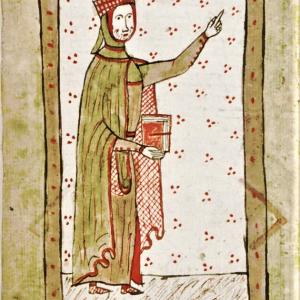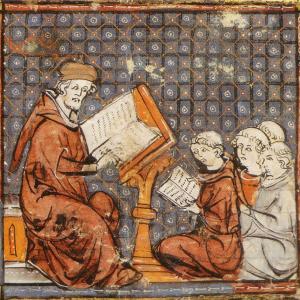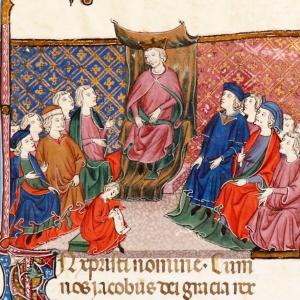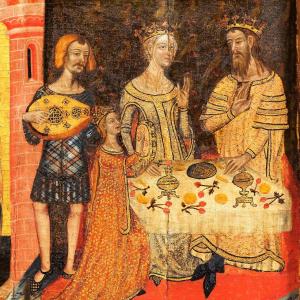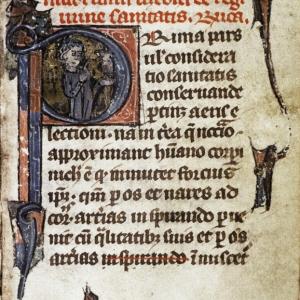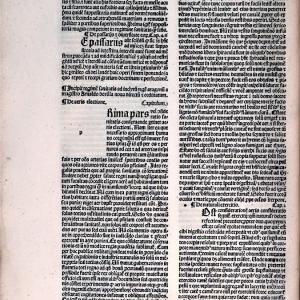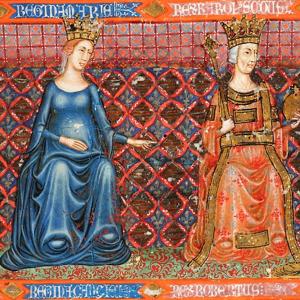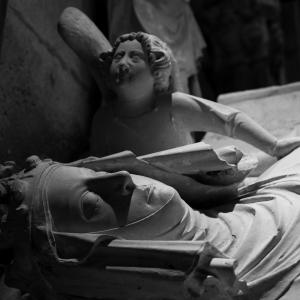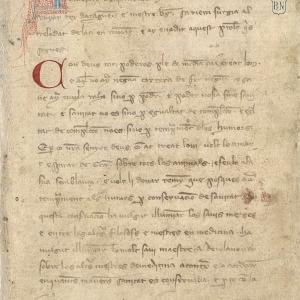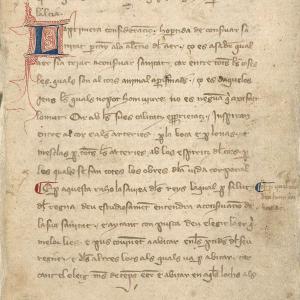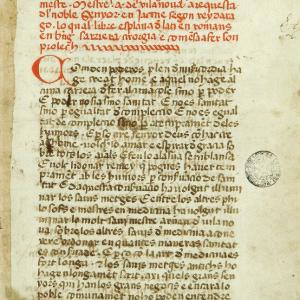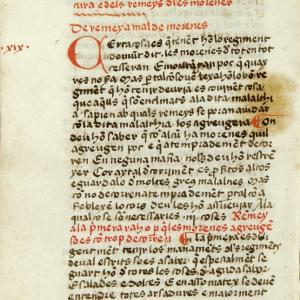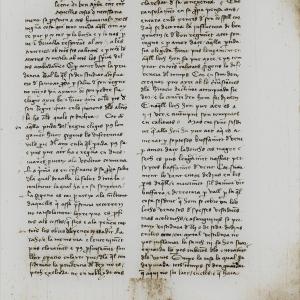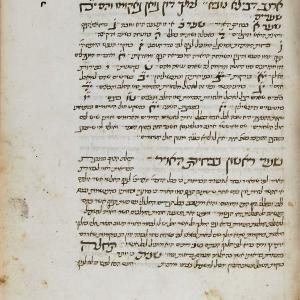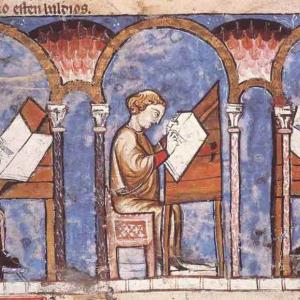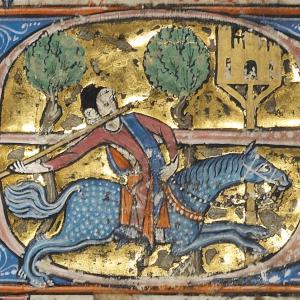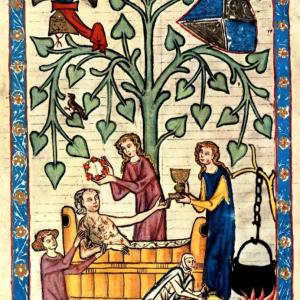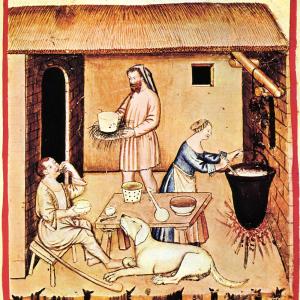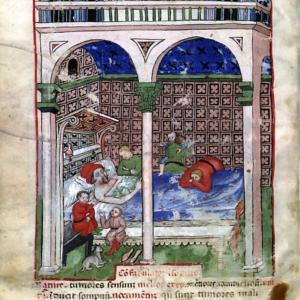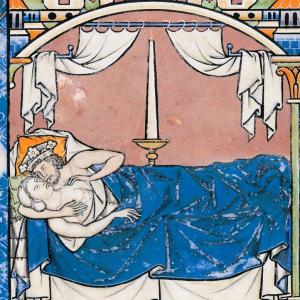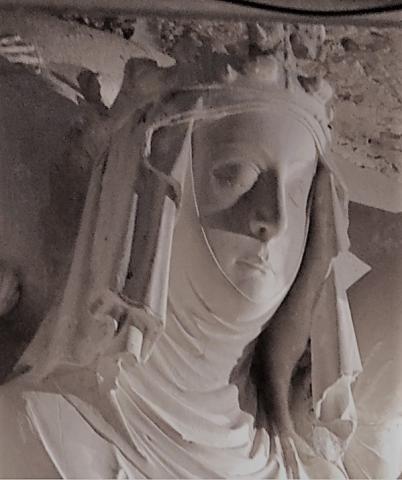
Arnald of Villanova’s 'Regimen of Health for the King of Aragon'
Born probably in Valencia, Arnald of Villanova (c. 1240-1311) (fig. 1) was one of the most important doctors in the Latin West. His prestige and renown derived from the fact that he wrote a large number of important medical treatises, both theoretical and practical, that were rapidly accepted and remained valid for a long time, and because he served as the doctor of as many as seven kings (Peter the Great, Alfons II and James II of Aragon; Frederick II of Sicily; Philip IV of France; Charles II and Robert I of Naples) and three Popes (Boniface VIII, Benedict XI and Clement V).
In Valencia, Arnald was admitted to the clerical estate, almost certainly while still a boy, and as an adult he lived in the city for long periods. One must bear in mind that the tonsured clerical estate, as it had not received major orders, was not at all opposed to marriage. Between 1260 and 1270, Arnald studied medicine at Montpellier and in that city – which then belonged to the Crown of Aragon – he graduated as a master of medicine. There he married Agnes Blasi, from a family of Montpellier merchants. Between 1290 and 1300 approximately he was a professor of medicine at the prestigious University of Montpellier, where he helped to reform the university studies of future doctors with the introduction to the curriculum of what has been called the “new Galen” (García Ballester 1982) (fig. 2).
Arnald was a layman who gained access to the world of knowledge. His case is a conspicuous example of the determined actions that, from the thirteenth century onwards, with the rebirth of urban society, were undertaken by laymen who were committed to gaining access to culture, hitherto only possible for the clergy, while at the same time expressing profound spiritual concerns that led them to devote their lives to spreading and reforming the faith (Soler, 1998). Although Arnald, as a university professor, only used Latin to write his medical works, laymen, in that new urban context, promoted the use of the vernacular languages in order to be able to advantageously gain access to knowledge and even new intellectual constructs conceived from outside academic circles (Cifuentes 2006; Badia, Santanach and Soler 2010 and 2016). Like Raymond Lull (1232-1316) or Dante Alighieri (1265-1321), Arnald of Villanova was a lay intellectual who strove to break down the barriers that separated the different fields of knowledge by becoming interested equally passionately in philosophy, theology and the sciences with practical applications. Arnald was a doctor who theologized (Ziegler 1998) and therefore he also wrote, often in Catalan, works on spiritual subjects in which he demonstrated his spiritual and social reforming zeal, which were not free of controversy (Mensa 2013).
Between 1305 and 1308, Arnald of Villanova wrote, in Latin, a “regimen of health” (regimen sanitatis) for his king, James II of Aragon (fig. 3), entitled Regimen sanitatis ad inclitum dominum regem Aragonum (Trias 1994; AVOMO X.1).
Broadly speaking, regimina sanitatis are practical hygiene handbooks aimed at ensuring the maintenance of individual or collective health by offering a general regimen for living. Indebted to Arab and Greek medicine, they consist of a collection of rules that teach people to act hygienically and to avoid excesses, which always entail terrible consequences for those who indulge in them. The majority are based on the “six non-natural things” (sex res non naturales) of Galenism and their direct impact on health or illness. There are ad personam regimens of health for a single individual, who will logically belong to the highest estates of society, and which are written in non-technical language, notable for including advice useful for some particular illness that the reader may suffer. There are also more university-based general regimens, written with greater professional rigour as they are meant for doctors, who have to use them to set the hygiene rules valid for a group.
The health regimen genre began to develop in the thirteenth century, was consolidated in the first half of the fourteenth, and achieved extraordinary dissemination during the entire fourteenth and fifteenth centuries. The genre was established between the rise of the scholastic university – the creator and transmitter of the new medical discourse – and the Black Death of 1348. For over 50 years, university trained doctors who were also professors in the faculties of medicine wrote several regimens of health, much better structured than those of the thirteenth century. The authors belonged to the professional elite, as is shown by their connections to the courts of princes, kings and popes. They wrote their regimens not as young men, but somewhat later in life, when they had already earned prestige and the trust of their patrons.
The most important regimen of health structured around the “six non-natural things” (see Notes in the margin) is the one written by Arnald of Villanova for King James II of Aragon, and it was to serve as a model for subsequent regimens. The Regimen sanitatis ad regem Aragonum provided the habitual title for works in the genre, and from then on it appeared in many others. It established the structure of the composition, based on parameters outside the human body, which would be repeated by many later treatises. And it set the rules of preventive medicine written in a way that was easy to understand and focused on medical practice (Nicoud 2007).
When he ordered a regimen of health from his trusted doctor, the most eminent and also his personal friend, James II wished to have to hand a systemic and practical set of rules for staying healthy, paying special attention to diet (fig. 4) and with constant references to his person (he had a sanguine constitution, and he suffered from haemorrhoids, joint pains and constipation).
Arnald of Villanova’s Regimen sanitatis ad regem Aragonum is the medieval hygiene text of which the most handwritten Latin copies have been conserved: 78 manuscripts from the fourteenth and fifteenth centuries, 61 of which contain the whole text (fig. 5). This profusion of copies shows that the work met very pressing needs in the urban society of the time and that, despite being designed for the Mediterranean context, it was popular all over the Latin West.
An abundance of handwritten testimonies like this one suggests a large number of later printed versions, and so there were. Twelve editions were produced in little over a century. The editio princeps was published at the beginning of 1470 somewhere in Italy and it is the only one that contains just the Regimen sanitatis. It was followed by three more incunabula (printed in Cologne before 1482; Leuven c. 1485, and Antwerp c. 1491) and eight later editions, in which the regimen formed part of Arnald’s Opera (Lyon 1504, Venice 1505, Lyon 1509, Lyon 1520, Venice 1527, Lyon 1532, Basel 1585 and Lyon 1586) (fig. 6).
The existence of translations into other languages is yet more proof of the success and the dissemination of a work, because they are made when there is a call for them in society. To date we know of the existence of translations (some of them partial) of Arnald’s regimen into six languages: Catalan, Hebrew, French, German, Italian and Castilian. The translations into Catalan, Hebrew, French, German and Italian – which unlike the previous complete ones, are only of the chapter on haemorrhoids – are medieval. The Castilian translation and another French one have survived in editions of the sixteenth and seventeenth centuries.
During Arnald’s lifetime Berenguer Sarriera, James II’s chief surgeon, translated the Regimen sanitatis into Catalan by order of Queen Blanche of Anjou (figs. 7-8), as he states in the important foreword that he added to the translation. It was done between 1305/1308, the date estimated for the original, and October or, at the very latest, December 1310, when the queen and Berenguer Sarriera died, respectively, but it was most likely done before 1310.
Queen Blanche might have commissioned the translation in preparation for a journey, and it is quite possibly the one she made in the Almeria campaign of 1309-1310, when the queen accompanied James II and for which occasion Arnald of Villanova could have written another regimen of health, known as Regimen Almarie, in this case for the king’s army (AVOMO X.2). The conquest of Almeria had been discussed at court since 1305, following or making use of Raymond Lull’s rex bellator proposal, and from December 1308 preparations for it were begun in earnest. The family precedent of Blanche of Anjou’s great-grandmother, Beatrice of Savoy, Countess of Provence, could have played a part in it. She had commissioned Aldobrandino of Siena to write her regimen of health entitled Livre de physique (Book of Medicine) or Régime du corps for a journey that she made to visit her four daughters, all reigning queens, as it states in one of the families of manuscripts that has transmitted the work, written in French in 1256 (at the present time, although there is no updated critical edition of the work, this dedication is the subject of debate, but, if it is not true, it might indicate that Beatrice had “adopted” it for her own use).
Could Queen Blanche have known about the existence of this regimen of health written in vernacular language, and thus wished to imitate her ancestor’s idea? Or perhaps, simply, the translations of works on different subjects into the spoken language that, as Sarriera states in the foreword, had begun to be written and circulated around her kingdoms gave her the idea to acquire one of such a useful handbook, on the subject of health, so sensitive and valued in the new urban context. Hers was always poor due to the many children that she bore and the court’s habitual itinerancy (the queen’s births and health in Martínez Fernando 1948). Whatever the reason, her initiative must have had the full backing of James II, himself the patron of several Catalan translations.
In any case, by doing this Blanche became one of the promoters of the process of the vernacularization of knowledge, which was especially active in everything that had to do with health, and not by chance. The fact that James and Blanche got involved in Arnald’s work shows that scholastic medicine had the patronage of royal courts, very clearly so in the Catalan case. And that Blanche should have been the commissioner of the Catalan translation shows that ladies also supported the task of translation, in the fields of medicine and science too.
The regimen of health that Arnald of Villanova wrote for James II was translated into Catalan twice. The first, and most important, translation is the one done by Berenguer Sarriera; the second one, done from an abridgement, is anonymous.
Berenguer Sarriera’s translation (Regiment de sanitat), done between 1305/1308 and 1310, is conserved in two manuscripts: MS 10078 in the Biblioteca Nacional de España, in Madrid (M), copied during the second quarter of the fourteenth century (figs. 9-10); and MS 1829 in the Biblioteca de Catalunya, in Barcelona (B), copied halfway through the fifteenth century (figs. 11-12). It is a good translation, faithful to the Latin text, that Sarriera heads with a foreword that is very notable for the attitude he displays in it and the information that he gives (Cifuentes 1999).
The anonymous translation (Summa del regiment de sanitat) was most surely done from a Latin version that shortened Arnald’s original text, although it has not yet been located. This Catalan translation is conserved in MS Barb. lat. 311 in the Biblioteca Apostolica Vaticana (V), copied in the second quarter or the middle of the fifteenth century (fig. 13). The translation, however, may be dated to before about 1327, not too long after Berenguer Sarriera’s, and the Latin abridgement must therefore have been very close to Arnald’s original.
The person this second translation, which has no foreword, was made for is not James II, because nearly all references to his royal person have been removed (especially, the chapter about haemorrhoids) and many of the sections dealing with the types of meats have been removed, as if eating meat was not so habitual in the social group to which it was initially addressed, the clergy perhaps. Both the Latin abridgement and the translation clearly show the great interest that Arnald’s work aroused in different types of readers.
This interest became even greater. The Catalan translations helped to disseminate the work among the Jewish communities of the northwestern Mediterranean arc, in which doctors and non-doctors longed to be able to make use of the knowledge emanating from the prestigious university institution, which paradoxically excluded them. Two of the Hebrew translations of the complete text of the Regimen sanitatis were made from Sarriera’s Catalan one: the one by Jucef ben Jafudà ha-Sefaradí, perhaps from Castelló d’Empúries, which must have been done in the late fourteenth century, with a long foreword by the translator (García Ballester, Ferre and Feliu 1990), and the one by Samuel ben David Eben-Soham, alias Burla, done in Taranto (in the south of the old kingdom of Naples) in 1466 (fig. 14). Moreover, one of the Hebrew translations of the abridged version was also done, by Israel ben Jucef Caslarí “twenty years after” Arnald’s original (about 1326-1327), from the Catalan translation of this abridgement (Feliu 2006-2007). They are mostly conserved in manuscripts of the fifteenth century written in Italy, which eliminate Sarriera’s foreword and, often, the chapter written for James II.
The Catalan translation of Arnald’s Regimen sanitatis ad regem Aragonum is one of the group of the earliest Catalan translations of medicine, science and technology, datable to the late thirteenth and early fourteenth centuries. This group includes some translations promoted by James II, such as those of the Secretum secretorum or the lost ones of different parts of Kitāb al-taṣrīf by Al-Zahrāwī (Albucasis), those of Thesaurus pauperum, Dragmaticon Philosophiae by William of Conches (Guillelmi de Conchis 1997), Chirurgia by Theodoric Borgognoni, The Canon of Medicine, Book IV by Ibn Sīnā (Avicenna), Hippocrates’ Aphorisms (Hipòcrates 2000) and Lilium medicinae by Bernard de Gordon (Carré and Cifuentes 2017), among others.
The process of handwritten transmission of the two Catalan translations of the Regimen sanitatis shows that the work was done by trained, responsible and aware professionals, with medical knowledge, who knew Latin and who almost certainly belonged to a copyists’ workshop (fig. 15). The text transmitted by MS B shows that the copyist did not restrict himself to copying Sarriera’s Catalan translation, but he acted with an editor’s judgement, as he compared the copy with a Latin text that he had in front of him, which allowed him to introduce amendments, to modify the text with changes in the order and of headings, to shorten certain parts or to add glosses in others. As some manuscripts of other works show (for example, those of the two Catalan translations of Theodoric Borgognoni’s Chirurgia, the complete one by Guillem Corretger and the partial one by Bernat de Berriac, studied by McVaugh 2012), this practice must have been more habitual than it might seem.
We cannot be sure, but professional copyists’ workshops specializing in this kind of woks, demand for which was increasing day by day, may quite possibly have existed in cities. This demand also meant that a higher quality product was expected. Authors like Raymond Lull created copyists’ workshops to disseminate their works. In the case of Arnald of Villanova who, unlike Llull, could turn to the university book circuit for this, the question of whether he created a workshop of this kind for his Latin medical works has not been studied, but he did have at least one, in the house of the Barcelona apothecary Pere Jutge, for copying spiritual works.
The large number of Latin manuscripts conserved and the existence of two very early Catalan translations of the Regimen sanitatis (Berenguer Sarriera’s and the anonymous abridged one) is proof of the immediate dissemination of the work in society. James II himself distributed Sarriera’s translation to the court and its circles, but the surviving post-mortem inventories indicate that the possessors of these two Catalan translations in the end belonged to different social estates: royalty and members of the nobility, ecclesiastics, and above all individuals from different areas of the bourgeoisie (notaries, jurists and “citizens” with unspecified occupations), some of them associated with medical care (non-university trained medical practitioners and apothecaries).
If the original and Sarriera’s translation were first addressed to kings, interest in this type of text, in Latin or in the vernacular, soon spread to all levels of society. In the cities especially, there was a large readership eager to acquire knowledge that could enrich them spiritually and also be useful in everyday life. This applies to the knowledge that regimens of health could give them, which had an immediate practical usefulness in a major aspect of life in the city, and they were even more useful when they could be read in the spoken language.
Thanks above all to the vernacular translations, the knowledge transmitted by medical texts was disseminated through all kinds of social, artistic and intellectual works, and it is evident in the fine arts and, especially, in literature, for example Raymond Lull’s Romanç d’Evast e Blaquerna, Francesc Eiximenis’ Lo crestià, Jaume Roig’s Espill, and Tirant lo Blanc by Joanot Martorell (Carré 2015).
Latin modern editions
- Arnaldi de Villanova, Regimen sanitatis ad regem Aragonum: un tractat de dietètica de l'any 1305, critical edition, commentaries and notes by A. Trias Teixidor, Barcelona, ETD, 1994.
- Arnaldi de Villanova, Regimen sanitatis ad regem Aragonum, edition by Luis García Ballester and Michael R. McVaugh, introduction by Pedro Gil-Sotres, with the collaboration of J. A. Paniagua and L. García Ballester, Barcelona, Fundació Noguera - Universitat de Barcelona (AVOMO, X.1), 1996.
Catalan modern editions
- Arnau de Vilanova, Obres catalanes, vol. 2 (Escrits mèdics), edition by M. Batllori, Barcelona, Barcino (ENC, A 56), 1947.
- Arnau de Vilanova, Regiment de sanitat per al rei d'Aragó - Aforismes de la memòria, critical edition by A. Carré, Barcelona, Universitat de Barcelona, 2017.
Selection of studies
- Arnau de Vilanova, Regimen Almarie (Regimen castra sequentium), edition by M. R. McVaugh, introduction and documents by M. R. McVaugh and L. Cifuentes, Barcelona, Fundació Noguera - Universitat de Barcelona (AVOMO, X.2), 1998.
- Arnau de Vilanova, Translatio libri Albuzale de medicinis simplicibus, edition by J. Martínez Gázquez and M. R. McVaugh. Abu-l-Salt Umayya, Kitab al-adwiya al-mufrada, edition by A. Labarta. Llibre d'Albumesar de simples medecines, edition by L. Cifuentes. Introduction and commentaries by A. Labarta, J. Martínez Gázquez, M. R. McVaugh, D. Jacquart and L. Cifuentes, Barcelona, Fundació Noguera - Universitat de Barcelona (AVOMO, XVII), 2004.
- L. Badia - J. Santanach - A. Soler, “Els manuscrits lul·lians de primera generació als inicis de la scripta librària catalana”, in A. Alberni, L. Badia i L. Cabré (eds.), Translatar i transferir: la transmissió dels textos i el saber (1200-1500), Santa Coloma de Queralt, Obrador Edèndum - Universitat Rovira i Virgili, 2010, pp. 61-90.
- L. Badia - J. Santanach - A. Soler, Ramon Llull as a Vernacular Writer: Communicating a New Kind of Knowledge, London, Tamesis, 2016.
- A. Carré, "Del Regiment de sanitat a la literatura: el cas d'Arnau de Vilanova", Anuario de Estudios Medievales, 45/1 (2015), 233-263.
- A. Carré - L. Cifuentes, La traducció catalana medieval del Lilium medicine de Bernat de Gordon: estudi i edició del fragment conservat (llibre VII, Antidotari), London, Queen Mary, University of London: Medieval Hispanic Research Seminar (Papers of the Medieval Hispanic Research Seminar, 76), 2017.
- L. Cifuentes i Comamala, “Vernacularization as an intellectual and social bridge: the Catalan translations of Teodorico's Chirurgia and of Arnau de Vilanova's Regimen sanitatis”, Early Science and Medicine, 4 (1999), 127-148.
- L. Cifuentes i Comamala, La ciència en català a l'Edat Mitjana i el Renaixement, Barcelona - Palma, Universitat de Barcelona - Universitat de les Illes Balears, 2006 [2nd rev. and enl. ed. of the original ed. of 2002, with an addenda on pp. 411-454].
- L. Cifuentes i Comamala, “La bibliografia mèdica catalana d’Arnau de Vilanova: estat de la qüestió i nous textos (amb una nota sobre la difusió a Catalunya d’una Vida d’Arnau)”, Arxiu de Textos Catalans Antics, 30 (2011-2013), 191-238.
- E. Feliu, "Les traduccions hebrees del Regiment de sanitat d'Arnau de Vilanova", Tamid, 6 (2006-2007), 45-141.
- L. García Ballester, “Arnau de Vilanova (c. 1240-1311) y la reforma de los estudios médicos en Montpeller (1309): el Hipócrates latino y la introducción del 'nuevo Galeno'”, Dynamis, 2 (1982), 97-158.
- L. García Ballester - L. Ferre - E. Feliu, "Jewish appreciation of fourteenth-century scholastic medicine", Osiris, 2a s., 6 [=Renaissance medical learning: evolution of a tradition, ed. M. R. McVaugh and N. G. Siraisi] (1990), 85-117.
- S. Giralt, Arnau de Vilanova en la impremta renaixentista, Barcelona, Col·legi Oficial de Metges de Barcelona (Publicacions de l'Arxiu Històric de les Ciències de la Salut), 2002.
- Guillelmi de Conchis, Summa de philosophia in vulgari, cura et studio L. Badia et J. Pujol, in Guillelmus de Conchis, Dragmaticon philosophiae, cura et studio I. Ronca, Turnhout, Brepols (Corpus Christianorum: Continuatio Medievalis, 152 / Guillelmi de Conchis Opera Omnia, 1), 1997, pp. 277-497.
- Hipòcrates, Aforismes: traducció catalana medieval, edition by A. Carré, with the collaboration of F. Llorens, Barcelona, Curial Edicions Catalanes - Publicacions de l'Abadia de Montserrat, 2000. [edition]
- M. R. McVaugh, “Academic medicine and the vernacularization of medieval surgery: the case of Bernat de Berriac”, in A. Alberni, L. Badia, L. Cifuentes and A. Fidora (eds.), El saber i les llengües vernacles a l'època de Llull i Eiximenis: estudis ICREA sobre vernacularització = Knowledge and Vernacular Languages in the Age of Llull and Eiximenis: ICREA Studies on Vernacularization, Barcelona, Publicacions de l’Abadia de Montserrat, 2012, pp. 257-281.
- J. E. Martínez Ferrando, Jaime II de Aragón: su vida familiar, 2 vols., Barcelona, CSIC: Escuela de Estudios Medievales, 1948.
- J. Mensa, "Arnau de Vilanova," in À. Broch (dir.), Història de la literatura catalana, vol. 1 (Literatura medieval, I: Dels orígens al segle XIV, ed. L. Badia), Barcelona, Enciclopèdia Catalana - Barcino - Ajuntament de Barcelona, 2013, pp. 476-509.
- M. Nicoud, Les régimes de santé au Moyen Âge: naissance et diffusion d’une écriture médicale en Italie et en France (XIIIe-XVe siècle), 2 vols., Rome, École française de Rome, 2007.
- M. de Riquer, “Un nuevo manuscrito con versiones catalanas de Arnau de Vilanova”, Analecta Sacra Tarraconensia, 22 (1949), 1-20.
- A. Soler, “Espiritualitat i cultura: els laics i l’accés al saber a final del segle XIII a la Corona d’Aragó”, Studia Lulliana, 38 (1998), 3-26.
- A. Soler, “Difondre i conservar la pròpia obra: Ramon Llull i el manuscrit Lat. Paris. 3348A”, Randa, 54 [=Homenatge a Miquel Batllori, 7] (2005), 5-29.
- A. Soler, “Descripció del manuscrit lul·lià F-143 del Col·legi de la Sapiència de Palma”, Barcelona, Publicacions de l’Abadia de Montserrat (Estudis de Llengua i Literatura Catalanes, 53 / Homenatge a Joseph Gulsoy, 1), 2006, pp. 13-23.
- I. Zamuner, "Il ms. Barb. lat. 311 e la transmissione dei regimina sanitatis (XIII-XV sec.)", Cultura Neolatina, 64/1-2 (2004), 207-250.
- J. Ziegler, Medicine and Religion c. 1300: the Case of Arnau de Vilanova, Oxford, Clarendon Press, 1998.
Corpus digital d’Arnau de Vilanova
- Information about the life, work and the legend of Arnald of Villanova.
- Description of MS 10078 in the Biblioteca Nacional de España, in Madrid (M), MS 1829 in the Biblioteca de Catalunya, in Barcelona (B), and MS Barb. lat. 311 in the Biblioteca Apostolica Vaticana (V).
- Description of MS 10078 in the Biblioteca Nacional de España, in Madrid (M), MS 1829 in Biblioteca de Catalunya, in Barcelona (B), and MS Barb. lat. 311 in the Biblioteca Apostolica Vaticana (V).
- Edition of the Regiment de sanitat per al rei d'Aragó and Aforismes de la memòria by Arnald of Villanova, by Antònia Carré (2017).
1. The “new Galen”
The name “new Galen” was given by Luis García Ballester (1982) to the new corpus of works that was introduced to university medical studies in the late thirteenth and early fourteenth centuries [estava equivocat], first in Montpellier and soon afterwards in all the faculties of medicine in Western Europe (Bologna, Padua, Paris and others). The reform involved the incorporation of new Galenist works to the curriculum, and it entailed an unprecedented broadening of the intellectual horizons of future doctors. This “new Galen”, which stressed pathology and therapeutics and which understood medicine as a tool for treating illness and not as a subject for scholastic speculation, consisted of the study and analysis of different treatises translated from Arabic into Latin: thirty-five works by Galen, the treatises of Arabic Galenism – especially Avicenna’s Canon of Medicine and the Liber Almansoris by Rhazes – both recently translated in Toledo, and the translations that had been made by Constantine the African in Montecassino, such as the Pantegni by Ali Abbas, Johannitius’ Isagoge and the works of Isaac Israeli.
2. The sex res non naturales (six non-natural things) of Galenism
The sex res non naturales (six non-natural things) is a core concept in Hippocratic-Galenist medical doctrine (Galenism), in force in the medicine of the West and the Arab world until the nineteenth century. It rationally explains the factors outside the human body that have an impact on health or disease and which must therefore be managed properly.
Based on the pattern established in Ali Abbas’ Pantegni and Johannitius’ Isagoge, which, except for one, expounds them in pairs, they are as follows:
- Air and environment: the environment. The air breathed in cools the innate heat of the human body and prevents the radical moisture from drying, the principle of life that ensures the functioning of the organism, but which is gradually consumed every day during life. Choosing “good” air and not “bad, corrupt” air to breathe is fundamental for the maintenance of health and may depend on the season of the year and the climate. Speaking about the air also means speaking about the rooms in houses (which must be properly ventilated) and clothes (which keep the body’s natural heat in) because they are elements that are part of the environment that surrounds the individual.
- Exercise and rest: movement. Physical exercise (fig. 16) is important because it moves the natural heat, eliminates superfluities from the body and strengthens the limbs, increasing muscle mass. The time, the duration and the way of doing it are prescribed, and also when and how it must not be done. Massages, bathing (fig. 17) and cleaning the body are aspects complementing the second non-natural thing. The two types of bath most usual in regimens of health are the steam bath (stupha) for the whole body, and the solium, which consists of wetting only a part of the body.
- Food and drink: nutrition. The third non-natural thing is
dietdietetics (different from the “diet”, which in Galenism was synonymous with a general regime of living), which covers food, both vegetable and animal in origin (fig. 18), and also drinks. Their quality and quantity is regulated, among other aspects. - Sleep and wakefulness: sleeping. Sleep is beneficial for the organism and the time, the duration and the way of sleeping must be regulated with moderation. Regimens speak about the healthiest postures and clothes for sleeping, and also about insomnia or wakefulness, voluntary or not (fig. 19).
- Excretion and secretion: waste. The fifth non-natural thing is the evacuation of waste produced by the three “digestions” (gastric, hepatic and blood), which are expelled with excrement, urine, sweat, semen, tears, mucus, spit, and so on. The means of evacuation used by Hippocratic-Galenist medicine are phlebotomy (or bleeding), cupping, scarification, leeching, cauterization, emetics, purgatives, enemas and suppositories. Sexual relations (fig. 20) are included here, considered by medical treatises to be a physiological question necessary for the maintenance of health, unconnected with pleasure and the emotional aspect that this may involve, although the regimens addressed to ecclesiastics provide alternatives to it.
- Movements of the soul: the emotions. The emotional movements of the sensitive soul, called “passions” by natural philosophers and “accidents” by doctors, are happiness, sadness, fear and rage, which are observed clinically by doctors. Singing and music contribute to happiness.
3. Arnald of Villanova’s medical works in Latin and the Catalan translations
As he was a university doctor, Arnald of Villanova wrote all his medical works in Latin. These are being published by an interdisciplinary team of internationally prestigious researchers in the collection Arnaldi de Villanova Opera Medica Omnia (AVOMO), published by the Fundació Noguera and the Universitat de Barcelona.
A small part of the medical work circulated in Catalan. Three Catalan translations have been conserved of two works by Arnald: the translation done by Berenguer Sarriera of the Regimen sanitatis ad regem Aragonum, the translation of the abridged version of this same regimen and the translation of the Aphorismi de memoria (all three published in Arnau de Vilanova 2017). Apart from these conserved translations, there was a Catalan translation of Practica summaria and another of Antidotarium that circulated in Arnald of Villanova’s name, although no manuscripts of them have been found (Cifuentes 2011-2013). Likewise, Arnald translated from Arabic into Latin the Kitāb al-adwiya al-mufrada (Liber de medicinis simplicibus) by Abū-s-Ṣalt of Dénia, a work that was later translated into Catalan (transcript in Arnau de Vilanova 2004). And, also, several loose prescriptions in Catalan, authentic or not, circulated in Arnald’s name, and some of the works in the extensive apocryphal corpus that was attributed to him (Cifuentes 2011-2013 and Arnau de Vilanova 2017)
4. Miquel Batllori’s edition of the Regiment de sanitat in Catalan (1947)
In 1947, Miquel Batllori published the first critical edition of the two Catalan translations of the Regimen of Health for the King of Aragon (in a volume that also contained that of the Aphorisms of Memory). He published Sarriera’s translation based on the only manuscript that was known at the time, MS 10078 in the National Library of Spain (figs. 9-10), which contains the incomplete text (three pages are missing). He had to make up for the missing part by translating it from the Latin text in the edition of the works of Arnald printed in Lyon in 1520, because then there was no Latin critical edition of this work. Miquel Batllori was aware that he was providing a worthy text of this important translation, but also that his work was provisional. Several scholars warned later of the mistakes contained in the Renaissance editions of Arnald, so they cannot be used for establishing the Latin text (Giralt 2002).
Miquel Batllori established the text rigorously and with few errors, understandable given the working tools that he had available in that period. In the “Preliminary Notice” that headed the edition, Batllori made a presentation of Arnald’s medical work and drew an exhaustive picture for the period of the medieval Catalan translations of medical works that have been conserved. Batllori’s study did not make clear whether the abridged version of the Regimen sanitatis came from Berenguer Sarriera’s translation or whether it was a different translation, but it has the merit of having compiled in a few pages everything that was known in those years.
Just two years later, in 1949, Martí de Riquer told of the existence, in a private collection, of another manuscript, this time complete, with Sarriera’s Catalan translation of Arnald’s Regimen sanitatis, which is now MS 1829 in the Biblioteca de Catalunya (figs. 11-12). This discovery was crying out for a new critical edition of Arnald’s text to be produced.
The publication of two Latin critical editions of the Regimen sanitatis (Arnau de Vilanova 1994 and 1996), the publication of one of the Catalan-Hebrew translations of the work (Feliu 2009), the new studies about the life and work of Arnald (Digital corpus of Arnald of Villanova) and, above all, the publication of important and complete studies about the genre of the regimina sanitatis (the one by Gil-Sotres in the 1996 Latin edition and by Nicoud 2007) have made possible the appearance of a new critical edition of the Catalan translations of the Regimen sanitatis, which incorporates the Catalan text that was missing and corrects the few mistakes that Batllori made, and which in the introduction updates the knowledge acquired over the last few decades (Arnau de Vilanova 2017).
1. Arnald of Villanova, depicted in the apocryphal work by Bertran Boisset La siensa de destrar, 1401 (Carpentras, Bibliothèque Municipale, MS 327, f. 127v). Despite being an apocryphal text, it is the oldest image of those intended to depict Arnald.
2. A medieval university lecture hall. Praise of the University of Paris, in Grandes chroniques de France (Castres, Bibliothèque Municipale, MS 3, f. 277r, around 1330).
3. James II presiding over the Parliament of Lleida in 1302, in a manuscript of the Constitucions de Catalunya (Paris, BnF, MS Lat. 4670A, f. 219r, 14-15th C).
4. A royal meal and feast at court. The image shows the dance of Salome, but reflecting the Catalan court of the period, with King Peter the Ceremonious, Eleanor of Sicily and the infanta Eleanor of Aragon, plus a troubadour or minstrel (altarpiece of the Saints John, from Santa Coloma de Queralt, MNAC, around 1356).
5. Latin manuscript of the Regimen sanitatis ad regem Aragonum by Arnald of Villanova (Oxford, Bodleian Library, MS Douce 2, f. 108r, France, 2nd quarter of the 14th C).
6. The Regimen sanitatis ad regem Aragonum in the edition of the works of Arnald printed in Lyon in 1504 (f. 79v).
7. Blanche of Anjou with the daughters of Charles II of Naples and Mary of Hungary (left), in the Anjou Bible (Catholic University of Leuven, Maurits Sabbebibliotheek, MS 1, around 1340).
8. Effigy of Queen Blanche of Anjou on her tomb, made by Bertran Riquer and Pere de Prenafeta between 1312 and 1315 (royal pantheon in the monastery of Santes Creus).
9. Foreword by Berenguer Sarriera in manuscript M of the Catalan translation of Arnald’s Regimen of Health (Madrid, BNE, MS 10078, f 3r).
10. Beginning of the text of the work in manuscript M of the Catalan translation of Arnald’s Regimen of Health (Madrid, BNE, MS 10078, f 5r).
11. Foreword by Berenguer Sarriera in manuscript B of the Catalan translation of Arnald’s Regimen of Health (Barcelona, BC, MS 1829, f 4r).
12. The final chapter, about James II’s haemorrhoids, in manuscript B of the Catalan translation of Arnald’s Regimen of Health (Barcelona, BC, MS 1829, f 34v).
13. Manuscript of the Catalan translation of the abridged version of Arnald’s Regimen of Health (Vatican, BAV, MS Barb. lat. 311, f. 5r).
14. Manuscript of the Hebrew translation by Samuel ben David Eben-Soham, alias Burla, done from Sarriera’s Catalan one in Taranto in 1466 (Paris, BnF, MS Hebrew 1128, f. 95r, 15th C).
15. Copyists working, in the Libro de los juegos by Alfonso X the Wise (El Escorial, MS T-I-6, 13th C).
16. Exercise is part of the second of the “non-natural things”. Image of the chapter "De astiludio, es assaber, juego de bofordar" (throwing spears at a target raised on a post), a game played by the nobility, in MS of the Laws (Fueros) of Aragon known as Vidal Mayor (Los Angeles, J. P. Getty Museum, MS Ludwig XIV-6, f. 229r, c. 1290-1310).
17. Bathing is part of the second of the “non-natural things”. Bathing the guest, in the Great Heidelberg Song Manuscript or Codex Manesse (University of Heidelberg, Cod. Pal. germ. 848, f. 46v, Zurich, c. 1305-1340).
18. Food and drink are the third of the “non-natural things”. Cheese-making in a manuscript of the Tacuinum sanitatis (Rome, Casanatense Library, MS 4182, 14th C).
19. Sleep and wakefulness are the fourth of the “non-natural things”. Insomnia in a manuscript of the Tacuinum sanitatis (Paris, BnF, MS Nouv. acq. lat. 1673, f. 90v, 15th C).
20. Sexual intercourse is an element of the fifth of the “non-natural things”. King David and Bathsheba, in the Morgan Bible (New York, Morgan Library, MS M.638, f. 41v, 13th C).
Translated by Andrew Stacey, 12/09/2017
